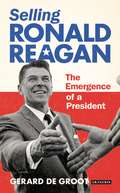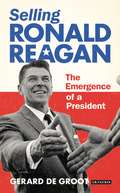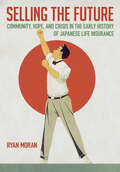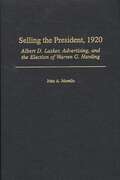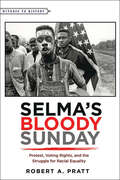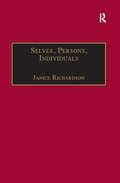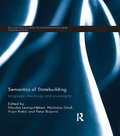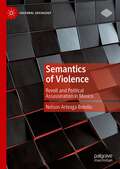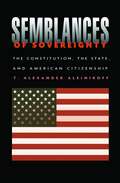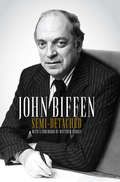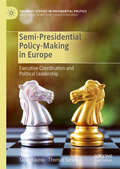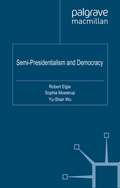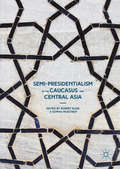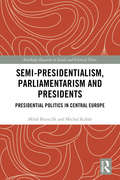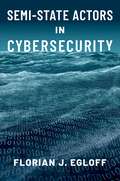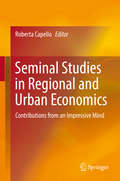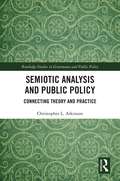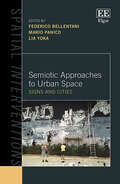- Table View
- List View
Selling Ronald Reagan: The Emergence of a President
by Gerard DeGrootBefore 1966, the idea of Reagan in politics provoked widespread scorn. To most people, he seemed a has-been actor, a right-wing extremist and a 'dunce'. Journalists therefore ridiculed his aspirations to be governor of California. No one, however, doubted his incredible ability to communicate with a crowd. In order to succeed in his campaign, Reagan had to be packaged as an outsider - an antidote to politics as usual. A highly sophisticated team of marketers and ad-men turned the scary right-winger into a harmless moderate who could attract supporters from across the political spectrum. Researchers meanwhile provided the coaching that allowed Reagan to seem well-informed - all of which led to Reagan winning the California governorship by a landslide. Gerard DeGroot here explores how, in the decade of consumerism, Reagan was marketed as a product. While there is no doubting his natural abilities as a campaigner, Reagan won in 1966 because his team of advisers understood how to sell their candidate, and he, wisely, allowed himself to be sold.Selling Ronald Reagan tells the story of Reagan's first election, when the nature of campaigning was forever altered and a titan of modern American history emerged.
Selling Ronald Reagan: The Emergence of a President
by Gerard DeGrootHow did Ronald Reagan go from being a washed-up Hollywood actor to the most powerful man in America? Running as a 'celebrity' candidate for the governorship of California in 1966, Ronald Reagan's hard-line republican campaign was faltering amongst the student riots in Berkeley and sixties counter-culture. Reagan's team, young. Hungry and inventive, including two Stanford psychologists, coached Reagan – teaching him to avoid getting caught up in policy detail and to refocus attention towards his natural ease in front of the camera and media-friendly charisma. In doing so Reagan and his team created the first 'modern' politician. With an emphasis on the importance of the sound-bite, the photo-op and Reagan's personality, they won the California governorship by a landslide, and went on to do the same in the US presidential elections.This is the untold story of Reagan's California campaign, which was to change the face of American politics, and sheds new light on one of the titans of modern American history.
Selling the Future: Community, Hope, and Crisis in the Early History of Japanese Life Insurance
by Ryan MoranIn Selling the Future, Ryan Moran explains how the life insurance industry in Japan exploited its association with mutuality and community to commodify and govern lives. Covering the years from the start of the industry in 1881 through the end of World War II, Moran describes insurance companies and government officials working together to create a picture of the future as precarious and dangerous. Since it was impossible for individual consumers to deal with every contingency on their own, insurance industry administrators argued that their usage of statistical data enabled them to chart the predictable future for the aggregate. Through insurance, companies and the state thus offered consumers a means to a perfectible future in an era filled with repeated crises. Life insurance functioned as an important modernist technology within Japan and its colonies to instantiate expectations for responsibility, to reconfigure meanings of mutuality, and to normalize new social formations (such as the nuclear family) as essential to life. Life insurance thus offers an important vehicle for examining the confluence of modes of mobilizing and organizing bodies, the expropriation of financial resources, and the action of disciplining workers into a capitalist system.
Selling the President, 1920: Albert D. Lasker, Advertising, and the Election of Warren G. Harding (Non-ser.)
by John A. MorelloModern advertising moved into the 20th century borne on many vehicles and distinguished by many techniques, three of the most frequently used being reason why advertising, celebrity endorsements, and pre-emptive claims. Best known for his reason why advertising, Albert Davis Lasker, president of the Lord & Thomas Agency of Chicago, championed all three techniques, helping Lucky Strike Cigarettes, Van Camp's Pork & Beans, and Sunkist Oranges become business successes. His least known but best work was in the political area, where he helped the Republicans gain control of Congress in 1918, and with the election of Warren G. Harding, recapture the White House in 1920.This book covers events leading to Harding's nomination and election and the key role Lasker played in his election. Bringing along the tricks he had used to sell soap, beer, cigarettes, and canned food, Lasker plunged into political advertising, forever changing the way political candidates are publicized.
Selma and the Liuzzo Murder Trials: The First Modern Civil Rights Convictions
by James P. TurnerIn 1965 the drive for black voting rights in the south culminated in the epic Selma to Montgomery Freedom March. After brutal state police beatings stunned the nation on “Bloody Sunday,” troops under federal court order lined the route as the march finally made its way to the State Capitol and a triumphant address by Dr. Martin Luther King, Jr. But within hours klan terror struck, claiming the life of one of the marchers, Viola Liuzzo, a Detroit mother of five. Turner offers an insider’s view of the three trials that took place over the following nine months—which finally resulted in the conviction of the killers. Despite eyewitness testimony by an FBI informant who was riding in the car with the killers, two all-white state juries refused to convict. It took a team of Civil Rights Division lawyers, led by the legendary John Doar, to produce the landmark jury verdict that klansmen were no longer above the law. This is must reading today, as the voting rights won in Selma come under renewed attack. Explore several court documents, including court transcripts, exhibits, and memoranda on Fulcrum.org.
Selma;€™s Bloody Sunday: Protest, Voting Rights, and the Struggle for Racial Equality (Witness to History)
by Robert A. PrattOn Sunday afternoon, March 7, 1965, roughly six hundred peaceful demonstrators set out from Brown Chapel A.M.E. Church in a double-file column to march from Selma, Alabama, to the state capital of Montgomery. Leading the march were Hosea Williams of the Southern Christian Leadership Conference and John Lewis of the Student Nonviolent Coordinating Committee. Upon reaching Broad Street, the marchers turned left to cross the Edmund Pettus Bridge that spanned the Alabama River. "When we reached the crest of the bridge," recalls John Lewis, "I stopped dead still. So did Hosea. There, facing us at the bottom of the other side, stood a sea of blue-helmeted, blue-uniformed Alabama state troopers, line after line of them, dozens of battle-ready lawmen stretched from one side of U.S. Highway 80 to the other. Behind them were several dozen more armed men;¢;‚¬;€?Sheriff Clark;€™s posse;¢;‚¬;€?some on horseback, all wearing khaki clothing, many carrying clubs the size of baseball bats."The violence and horror that was about to unfold at the foot of the bridge would forever mark the day as "Bloody Sunday," one of the pivotal moments of the civil rights movement. Alabama state troopers fell on the unarmed protestors as they crossed the bridge, beating and tear gassing them. In Selma;€™s Bloody Sunday, Robert A. Pratt offers a vivid account of that infamous day and the indelible triumph of black and white protest over white resistance. He explores how the march itself;¢;‚¬;€?and the 1965 Voting Rights Act that followed;¢;‚¬;€?represented a reaffirmation of the nation;€™s centuries-old declaration of universal equality and the fulfillment of the Fifteenth Amendment to the Constitution.Selma;€™s Bloody Sunday offers a fresh interpretation of the ongoing struggle by African Americans to participate freely in America;€™s electoral democracy. Jumping forward to the present day, Pratt uses the march as a lens through which to examine disturbing recent debates concerning who should, and who should not, be allowed to vote. Drawing on archival materials, secondary sources, and eyewitness accounts of the brave men and women who marched, this gripping account offers a brief and nuanced narrative of this critical phase of the black freedom struggle.
Selma;€™s Bloody Sunday: Protest, Voting Rights, and the Struggle for Racial Equality (Witness to History)
by Robert A. PrattOn Sunday afternoon, March 7, 1965, roughly six hundred peaceful demonstrators set out from Brown Chapel A.M.E. Church in a double-file column to march from Selma, Alabama, to the state capital of Montgomery. Leading the march were Hosea Williams of the Southern Christian Leadership Conference and John Lewis of the Student Nonviolent Coordinating Committee. Upon reaching Broad Street, the marchers turned left to cross the Edmund Pettus Bridge that spanned the Alabama River. "When we reached the crest of the bridge," recalls John Lewis, "I stopped dead still. So did Hosea. There, facing us at the bottom of the other side, stood a sea of blue-helmeted, blue-uniformed Alabama state troopers, line after line of them, dozens of battle-ready lawmen stretched from one side of U.S. Highway 80 to the other. Behind them were several dozen more armed men;¢;‚¬;€?Sheriff Clark;€™s posse;¢;‚¬;€?some on horseback, all wearing khaki clothing, many carrying clubs the size of baseball bats."The violence and horror that was about to unfold at the foot of the bridge would forever mark the day as "Bloody Sunday," one of the pivotal moments of the civil rights movement. Alabama state troopers fell on the unarmed protestors as they crossed the bridge, beating and tear gassing them. In Selma;€™s Bloody Sunday, Robert A. Pratt offers a vivid account of that infamous day and the indelible triumph of black and white protest over white resistance. He explores how the march itself;¢;‚¬;€?and the 1965 Voting Rights Act that followed;¢;‚¬;€?represented a reaffirmation of the nation;€™s centuries-old declaration of universal equality and the fulfillment of the Fifteenth Amendment to the Constitution.Selma;€™s Bloody Sunday offers a fresh interpretation of the ongoing struggle by African Americans to participate freely in America;€™s electoral democracy. Jumping forward to the present day, Pratt uses the march as a lens through which to examine disturbing recent debates concerning who should, and who should not, be allowed to vote. Drawing on archival materials, secondary sources, and eyewitness accounts of the brave men and women who marched, this gripping account offers a brief and nuanced narrative of this critical phase of the black freedom struggle.
Selves, Persons, Individuals: Philosophical Perspectives on Women and Legal Obligations
by Janice RichardsonWhilst feminist philosophy has frequently engaged with political theory, this original book instead considers legal theory and the practical operation of law. The work considers some of the contested meanings of what it is to be a self, a person or an individual in relation to the law of obligations. The discussion still impacts upon political theory as it concerns the way in which the question of what it is to be a woman has been defined within recent feminist theory. In order to overcome what appears to be a block in feminist legal theory, the book draws together areas of philosophy which are not normally considered within feminist or legal theory.
Selves, Persons, Individuals: Philosophical Perspectives on Women and Legal Obligations
by Janice RichardsonWhilst feminist philosophy has frequently engaged with political theory, this original book instead considers legal theory and the practical operation of law. The work considers some of the contested meanings of what it is to be a self, a person or an individual in relation to the law of obligations. The discussion still impacts upon political theory as it concerns the way in which the question of what it is to be a woman has been defined within recent feminist theory. In order to overcome what appears to be a block in feminist legal theory, the book draws together areas of philosophy which are not normally considered within feminist or legal theory.
Semantics of Statebuilding: Language, meanings and sovereignty (Routledge Studies in Intervention and Statebuilding)
by Nicolas Lemay-Hébert Nicholas Onuf Vojin Raki 263 Petar Bojani 263This volume examines international statebuilding in terms of language and meanings, rather than focusing narrowly on current policy practices. After two decades of evolution towards more ‘integrated,’ ‘multi-faceted’ or, simply stated, more intrusive statebuilding and peacebuilding operations, a critical literature has slowly emerged on the economic, social and political impacts of these interventions. Scholars have started to analyse the ‘unintended consequences’ of peacebuilding missions, analysing all aspects of interventions. Central to the book is the understanding that language is both the most important tool for building anything of social significance, and the primary repository of meanings in any social setting. Hence, this volume exemplifies how the multiple realities of state, state fragility and statebuilding are being conceptualised in mainstream literature, by highlighting the repercussions this conceptualisation has on ‘good practices’ for statebuilding. Drawing together leading scholars in the field, this project provides a meeting point between constructivism in international relations and the critical perspective on liberal peacebuilding, shedding new light on the commonly accepted meanings and concepts underlying the international (or world) order, as well as the semantics of contemporary statebuilding practices. This book will be of much interest to students of statebuilding and intervention, war and conflict studies, security studies and international relations.
Semantics of Statebuilding: Language, meanings and sovereignty (Routledge Studies in Intervention and Statebuilding)
by Nicolas Lemay-Hébert Nicholas Onuf Vojin Rakić Petar BojanićThis volume examines international statebuilding in terms of language and meanings, rather than focusing narrowly on current policy practices. After two decades of evolution towards more ‘integrated,’ ‘multi-faceted’ or, simply stated, more intrusive statebuilding and peacebuilding operations, a critical literature has slowly emerged on the economic, social and political impacts of these interventions. Scholars have started to analyse the ‘unintended consequences’ of peacebuilding missions, analysing all aspects of interventions. Central to the book is the understanding that language is both the most important tool for building anything of social significance, and the primary repository of meanings in any social setting. Hence, this volume exemplifies how the multiple realities of state, state fragility and statebuilding are being conceptualised in mainstream literature, by highlighting the repercussions this conceptualisation has on ‘good practices’ for statebuilding. Drawing together leading scholars in the field, this project provides a meeting point between constructivism in international relations and the critical perspective on liberal peacebuilding, shedding new light on the commonly accepted meanings and concepts underlying the international (or world) order, as well as the semantics of contemporary statebuilding practices. This book will be of much interest to students of statebuilding and intervention, war and conflict studies, security studies and international relations.
Semantics of Violence: Revolt and Political Assassination in Mexico (Cultural Sociology)
by Nelson Arteaga BotelloThis book describes three impactful cases of political violence that broke out in Mexico in 1994, pointing to an important juncture in Mexican political development. At that point, the patrimonial order centered on the PRI and the Mexican presidency entered a momentous crisis that is still ongoing after a quarter of a century and caused the patrimonial order and the civil order to compete over Mexican public life. Such competition, in turn, unfolds at the cultural level on the terrain of three semantics of political violence that shape public debates over violence in Mexico. Ultimately, this book sheds light over the refraction of patrimonial and civil attributions across such cultural terrains.
Semblances of Sovereignty: The Constitution, the State, and American Citizenship
by T. Alexander AleinikoffIn a set of cases decided at the end of the nineteenth century, the Supreme Court declared that Congress had "plenary power" to regulate immigration, Indian tribes, and newly acquired territories. Not coincidentally, the groups subject to Congress' plenary power were primarily nonwhite and generally perceived as "uncivilized." The Court left Congress free to craft policies of assimilation, exclusion, paternalism, and domination.Despite dramatic shifts in constitutional law in the twentieth century, the plenary power case decisions remain largely the controlling law. The Warren Court, widely recognized for its dedication to individual rights, focused on ensuring "full and equal citizenship"--an agenda that utterly neglected immigrants, tribes, and residents of the territories. The Rehnquist Court has appropriated the Warren Court's rhetoric of citizenship, but has used it to strike down policies that support diversity and the sovereignty of Indian tribes.Attuned to the demands of a new century, the author argues for abandonment of the plenary power cases, and for more flexible conceptions of sovereignty and citizenship. The federal government ought to negotiate compacts with Indian tribes and the territories that affirm more durable forms of self-government. Citizenship should be "decentered," understood as a commitment to an intergenerational national project, not a basis for denying rights to immigrants.
Semi-Detached
by John BiffenImmensely respected on both sides of the House, John Biffen was a man of charm, wisdom and intelligence. Celebrated as one of the cleverest and nicest politicians around, he brought to the Conservative benches one of the most original economic minds of his generation. Biffen served as Chief Secretary to the Treasury and Secretary of State for Trade, but it was as Leader of the House of Commons that he really made his mark. Over time, he found himself increasingly at odds with the divisive nature and style of Margaret Thatcher's government. Thatcher was unreceptive and he was slowly frozen out. In sacking Biffen from her Cabinet, she lost one of the more human faces of her government. With its candid account of the subject's battle with depression, this fascinating autobiography, with extensive extracts from his unpublished diaries, is a portrait of great humanity and determination set against the backdrop of public life. Semi-Detached revisits dramatic and poignant moments from Biffen's personal life and from the corridors of power, presenting a moving and penetrating portrayal of one of the twentieth century's most remarkable politicians.
Semi-Presidential Policy-Making in Europe: Executive Coordination and Political Leadership (Palgrave Studies in Presidential Politics)
by Tapio Raunio Thomas SedeliusThis book explores how power-sharing between the president and the prime minister works in semi-presidential regimes. In contrast to much of the existing comparative work on semi-presidentialism, the book emphasizes the role of institutional coordination at the most concrete level of executive policy-making, and asks how institutional coordination between the president and prime minister influences presidential activism and the balance of power within the executive. The authors develop a tentative framework embedded in institutionalism and based on four strands of research – semi-presidentialism, public administration, political leadership, and foreign policy analysis – which is subsequently applied to the cases of Lithuania, Romania and Finland. Given the political challenges facing many semi-presidential countries, the study ultimately seeks to identify institutional solutions that facilitate power-sharing and successful policy-making.
Semi-Presidentialism and Democracy
by Sophia MoestrupExplores the effect of semi-presidentialism on newly-democratising countries. In recent years semi-presidentialism - the situation where a constitution makes provision for both a directly elected president and a prime minister who is responsible to the legislature - has become the regime type of choice for many countries.
Semi-Presidentialism in the Caucasus and Central Asia (Palgrave Studies In Political Leadership Ser.)
by Robert Elgie Sophia MoestrupThis edited collection examines the politics of semi-presidential countries in the Caucasus and Central Asia. Semi-presidentialism is the situation where there is both a directly elected fixed-term president and a prime minister and cabinet that are collectively responsible for the legislature. There are four countries with a semi-presidential constitution in this region - Armenia, Azerbaijan, Georgia, and Kyrgyzstan. The authors introduce the concept of semi-presidentialism, place the countries in a general post-Soviet context, and compare them with Kazakhstan. They investigate the relationship between semi-presidentialism in the formal constitution and the verticality of power in reality, explore the extent to which semi-presidentialism has been responsible for the relative performance of democracy in each country, and chart the relationship within the executive both between the president, prime minister and ministers, and between the executive and the legislature.
Semi-presidentialism, Parliamentarism and Presidents: Presidential Politics in Central Europe (Routledge Research on Social and Political Elites)
by Miloš Brunclík Michal KubátThe book analyzes the presidencies of three neighboring Central European countries – Poland, the Czech Republic and Slovakia – in the context of their interactions with cabinets (and prime ministers), parliaments and the constitutional courts, all which have proved crucial actors in the region’s political and constitutional battles. Using both institutional and behavioral perspectives along with an innovative definition of semi-presidentialism, the book argues that presidential powers – rather than the mode of the election of the president – are crucial to the functioning of the regimes and their classification into distinctive regime types. Focusing on intra-executive conflicts and the interaction of the president with other constitutional players it argues that, regardless of the mode of the election of the president, regimes have traditionally been very similar not only in their institutional settings, but also in the way they function. Finally, it shows that Poland, the Czech Republic and Slovakia should be classified as parliamentary regimes. This text will be of key interest to scholars and students of Central and East Europe studies/politics, post-Communist studies, presidential studies and more broadly to political elites and institutions, comparative politics and legislative studies.
Semi-presidentialism, Parliamentarism and Presidents: Presidential Politics in Central Europe (Routledge Research on Social and Political Elites)
by Miloš Brunclík Michal KubátThe book analyzes the presidencies of three neighboring Central European countries – Poland, the Czech Republic and Slovakia – in the context of their interactions with cabinets (and prime ministers), parliaments and the constitutional courts, all which have proved crucial actors in the region’s political and constitutional battles. Using both institutional and behavioral perspectives along with an innovative definition of semi-presidentialism, the book argues that presidential powers – rather than the mode of the election of the president – are crucial to the functioning of the regimes and their classification into distinctive regime types. Focusing on intra-executive conflicts and the interaction of the president with other constitutional players it argues that, regardless of the mode of the election of the president, regimes have traditionally been very similar not only in their institutional settings, but also in the way they function. Finally, it shows that Poland, the Czech Republic and Slovakia should be classified as parliamentary regimes. This text will be of key interest to scholars and students of Central and East Europe studies/politics, post-Communist studies, presidential studies and more broadly to political elites and institutions, comparative politics and legislative studies.
Semi-State Actors in Cybersecurity
by Florian J. EgloffThe universe of actors involved in international cybersecurity includes both state actors and semi- and non-state actors, including technology companies, state-sponsored hackers, and cybercriminals. Among these are semi-state actors--actors in a close relationship with one state who sometimes advance this state's interests, but are not organizationally integrated into state functions. In Semi-State Actors in Cybersecurity, Florian J. Egloff argues that political relations in cyberspace fundamentally involve concurrent collaboration and competition between states and semi-state actors. To understand the complex interplay of cooperation and competition and the power relations that exist between these actors in international relations, Egloff looks to a historical analogy: that of mercantile companies, privateers, and pirates. Pirates, privateers, and mercantile companies were integral to maritime security between the 16th and 19th centuries. In fact, privateers and mercantile companies, like today's tech companies and private cyber contractors, had a particular relationship to the state in that they conducted state-sanctioned private attacks against foreign vessels. Pirates, like independent hackers, were sometimes useful allies, and other times enemies. These actors traded, explored, plundered, and controlled sea-lanes and territories across the world's oceans--with state navies lagging behind, often burdened by hierarchy. ** Today, as cyberspace is woven into the fabric of all aspects of society, the provision and undermining of security in digital spaces has become a new arena for digital pirates, privateers, and mercantile companies. In making the analogy to piracy and privateering, Egloff provides a new understanding of how attackers and defenders use their proximity to the state politically and offers lessons for understanding how actors exercise power in cyberspace. Drawing on historical archival sources, Egloff identifies the parallels between today's cyber in-security and the historical quest for gold and glory on the high seas. The book explains what the presence of semi-state actors means for national and international security, and how semi-state actors are historically and contemporarily linked to understandings of statehood, sovereignty, and the legitimacy of the state.
Semi-State Actors in Cybersecurity
by Florian J. EgloffThe universe of actors involved in international cybersecurity includes both state actors and semi- and non-state actors, including technology companies, state-sponsored hackers, and cybercriminals. Among these are semi-state actors--actors in a close relationship with one state who sometimes advance this state's interests, but are not organizationally integrated into state functions. In Semi-State Actors in Cybersecurity, Florian J. Egloff argues that political relations in cyberspace fundamentally involve concurrent collaboration and competition between states and semi-state actors. To understand the complex interplay of cooperation and competition and the power relations that exist between these actors in international relations, Egloff looks to a historical analogy: that of mercantile companies, privateers, and pirates. Pirates, privateers, and mercantile companies were integral to maritime security between the 16th and 19th centuries. In fact, privateers and mercantile companies, like today's tech companies and private cyber contractors, had a particular relationship to the state in that they conducted state-sanctioned private attacks against foreign vessels. Pirates, like independent hackers, were sometimes useful allies, and other times enemies. These actors traded, explored, plundered, and controlled sea-lanes and territories across the world's oceans--with state navies lagging behind, often burdened by hierarchy. ** Today, as cyberspace is woven into the fabric of all aspects of society, the provision and undermining of security in digital spaces has become a new arena for digital pirates, privateers, and mercantile companies. In making the analogy to piracy and privateering, Egloff provides a new understanding of how attackers and defenders use their proximity to the state politically and offers lessons for understanding how actors exercise power in cyberspace. Drawing on historical archival sources, Egloff identifies the parallels between today's cyber in-security and the historical quest for gold and glory on the high seas. The book explains what the presence of semi-state actors means for national and international security, and how semi-state actors are historically and contemporarily linked to understandings of statehood, sovereignty, and the legitimacy of the state.
Seminal Studies in Regional and Urban Economics: Contributions from an Impressive Mind
by Roberta CapelloThe book spans a scientific research program elegantly developed by Roberto Camagni, an eminent regional scientist, who has offered ground-breaking ideas in regional and urban economics throughout his academic career. In addition to bringing together a selection of Professor Camagni’s most influential works, the book presents syntheses and interpretations of his ideas by respected colleagues and by his students. In regional economics, space as territory, which plays an active role in innovation processes and in regional growth patterns; territorial capital as a synthetic concept of differentiated regional growth assets; and sources of regional competitiveness are only a few of the main ideas that emerged in regional economics thanks to this inspiring mind. In urban economics, he paved the way towards a new theoretical interpretation of the existence of the city and of its dynamics. His theory of city networks overcame the limits of Christaller’s and Lösch’s spatial approach to the city, with a solid economic conceptualization of spatial city network structures. All theories are accompanied by sound policy analysis, helping to contribute to the design and implementation of appropriate spatial policies at the European level.
Semiotic Analysis and Public Policy: Connecting Theory and Practice (Routledge Studies in Governance and Public Policy)
by Christopher L. AtkinsonSemiotic Analysis and Public Policy evaluates several key areas of public policy that are dependent on narrative, naming, sign, and branding to create meaning. Semiotic analysis, drawing on the work of Saussure, Peirce, and others, allows for creation of a case-oriented model of brand versus product, and of medium compared with message. Using a critical Habermasian lens, Atkinson convincingly exposes approaches focusing too heavily on instrumentality and rhetoric that claims a resolution of complex societal dilemmas. Rooted in the literature on public policy and semiotics, Atkinson creates an opportunity to delve more fully into the creation of narratives and meaning in policy, and the origins and maintenance of public programs. Evaluation of such programs shows various levels of disconnect between popular understanding of public considerations, political outcomes, and what results from the administrative/regulatory process in support of the law. This book will be of interest for scholars and researchers of public policy, policy analysis, public administration, public management, and policy implementation.
Semiotic Analysis and Public Policy: Connecting Theory and Practice (Routledge Studies in Governance and Public Policy)
by Christopher L. AtkinsonSemiotic Analysis and Public Policy evaluates several key areas of public policy that are dependent on narrative, naming, sign, and branding to create meaning. Semiotic analysis, drawing on the work of Saussure, Peirce, and others, allows for creation of a case-oriented model of brand versus product, and of medium compared with message. Using a critical Habermasian lens, Atkinson convincingly exposes approaches focusing too heavily on instrumentality and rhetoric that claims a resolution of complex societal dilemmas. Rooted in the literature on public policy and semiotics, Atkinson creates an opportunity to delve more fully into the creation of narratives and meaning in policy, and the origins and maintenance of public programs. Evaluation of such programs shows various levels of disconnect between popular understanding of public considerations, political outcomes, and what results from the administrative/regulatory process in support of the law. This book will be of interest for scholars and researchers of public policy, policy analysis, public administration, public management, and policy implementation.
Semiotic Approaches to Urban Space: Signs and Cities (Spatial Interventions)
This book outlines the future of semiotic research in the study of urban spaces, with chapters authored by leading scholars in the field. It offers thought-provoking explanations of semiotic theory, methodology and applications with the goal of exploring recently developed approaches to the interpretive aspects of urban space.Capturing the advances in research techniques within the field, this book will introduce the reader to key contemporary debates within the study of urban spaces. Chapters focus on the important topics of meaning-making and interpretation within cities. State-of-the-art approaches are presented to provide an enlightening outlook into this ever-evolving subject area.Semiotic Approaches to Urban Space will be a valuable resource for both undergraduates and postgraduates in the fields of semiotics and urban studies, alongside those in disciplines such as visual studies and human geography. Researchers in these fields will find the cutting-edge research within this book to be of great interest.
